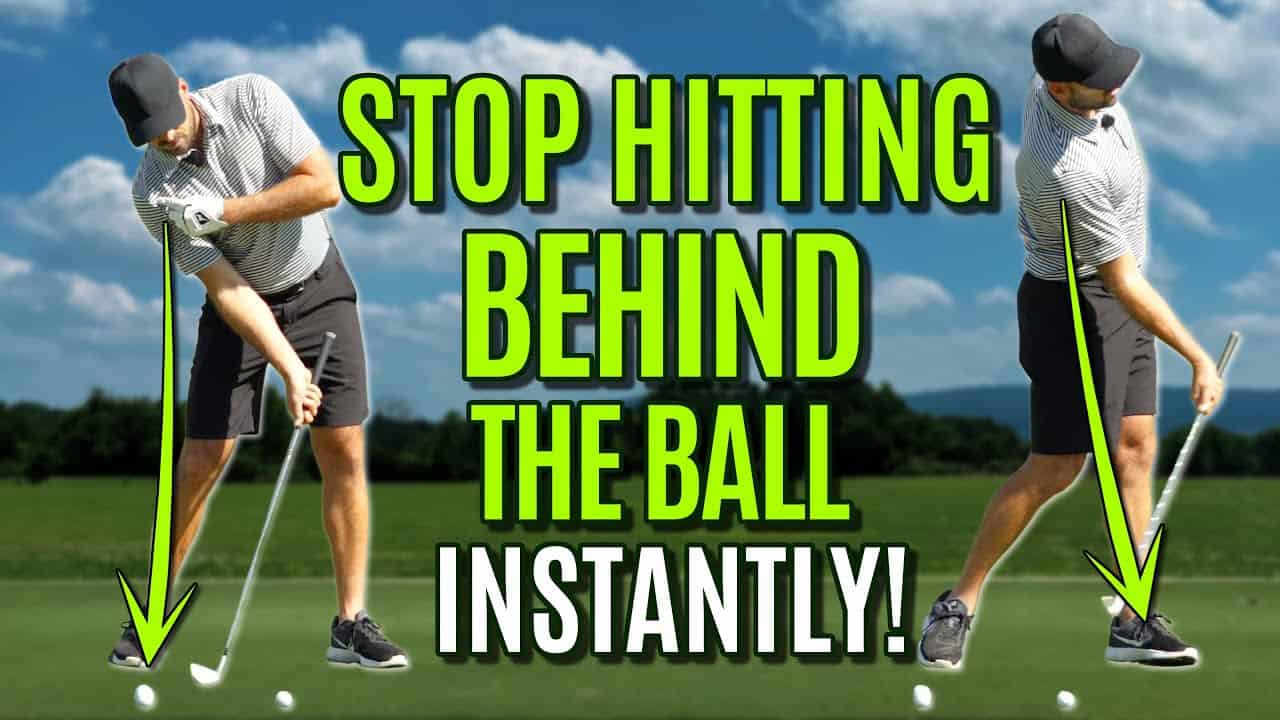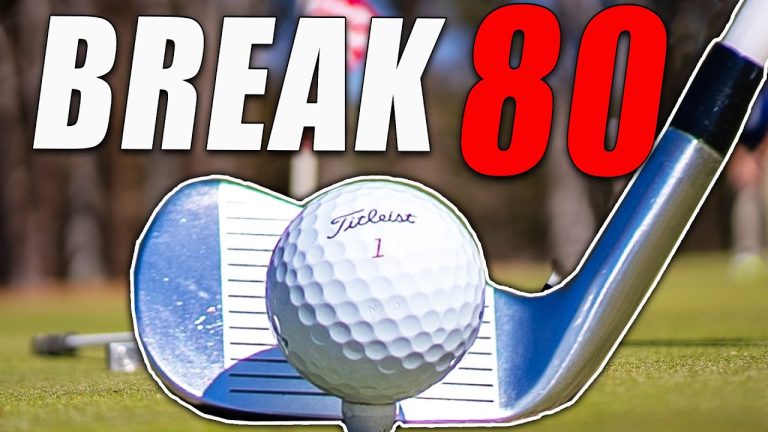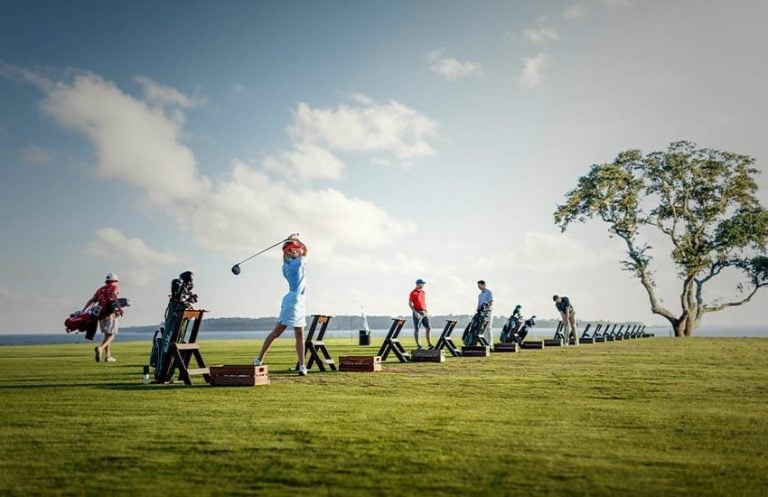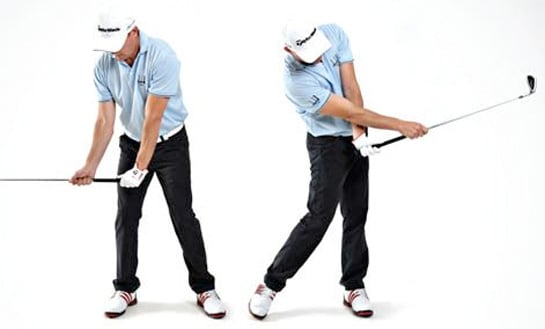Getting Rid of Fat Shots: How to Stop Hitting Behind the Golf Ball
Key Takeaway:
- To stop hitting behind the golf ball, it is important to understand the problem and its common causes.
- Proper technique, including weight transfer in the swing, is crucial in correcting swing errors and improving contact.
- Tips and drills such as positioning the ball correctly, filming and analyzing your swing, and practicing proper weight transfer can help improve contact.
Introduction
Struggling with hitting behind the golf ball? In this section, we’ll dive into the root of the problem and uncover common causes that lead to this frustrating occurrence. Stay tuned for a closer look at the explanation of the issue and gain insights to improve your game.

Explanation of the problem of hitting behind the golf ball
Hitting behind the golf ball is a common issue for many golfers. This means the club makes contact with the ground before the ball, leading to less power and accuracy. Causes of this include incorrect weight distribution, swing errors and head movement.
To fix this, technique is key. Weight transfer is important. Most weight should be on the front foot during impact.
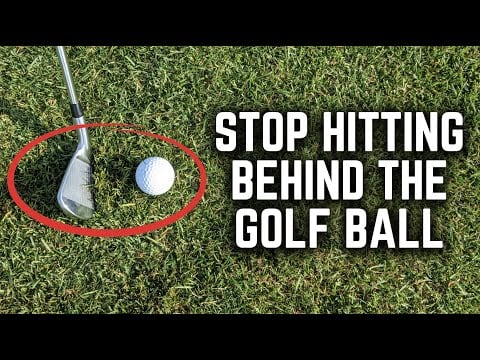
Swing errors need adjustments. Spine angle should be kept throughout the swing by tucking the shoulder under the chin. Also, it’s important to focus on hip rotation instead of sliding.
Head movement should be kept behind or over the ball during the entire swing. This will help with alignment and contact with the body’s center of gravity.
Practice and drills can help. The ball should be placed correctly for each club. Video analysis can identify and fix flaws in the swing.
Weight should be transferred to the front foot during downswing. The “Toe Drill” and tee drill can be used to improve impact position and contact.
Focusing on mistakes, taking lessons and practicing regularly are all ways to improve hitting behind the golf ball. Mistakes should be seen as opportunities to refine technique.
Common causes of hitting behind the ball
Hitting behind the ball can be an annoying issue for golfers of all levels.

Here are some common causes:
- Weight transfer. Incorrect weight distribution affects contact. Keeping balance in the swing is important.
- Spine angle. Failing to keep the spine angle consistent leads to hitting the ground before the ball. Tuck the shoulder under the chin to avoid this.
- Sliding instead of turning. Hip rotation is key. Sliding causes contact with the ground too early. Focus on proper hip rotation.
- Head movement. Moving the head forward too much hinders contact. Keep the head behind the ball for stability.
The Importance of Proper Technique
Understanding the importance of proper technique in golf is essential for improving your game. In this section, we will explore two key aspects: the role of weight transfer in the swing and correcting swing errors. By delving into these topics, you will gain valuable insights into improving your golf swing and ultimately preventing hitting behind the ball.

Understanding the role of weight transfer in the swing
Weight transfer is essential for a successful golf swing. It affects how the club makes contact with the ball and the outcome of each shot. Weight transfer, weight distribution, balance, and spine angle are key to improving performance on the course.
Weight distribution matters when it comes to clubhead and ball contact. Transferring the weight to the front foot during impact makes for a stronger and more solid hit.
Maintaining balance throughout the swing is crucial for accuracy and consistency. Keeping a stable center of gravity optimizes the chance of making a good shot.
Failing to maintain the proper spine angle causes hitting behind the ball. Tuck your shoulder under your chin to keep the angle right.
Focus on hip rotation during the swing for optimal power and accuracy. Keep your head behind the ball to ensure correct contact and avoid mishits.
For better contact with the ball, position it correctly based on club selection. Use video analysis to identify swing flaws. Practice weight transfer in practice sessions and use the “Toe Drill” or a tee drill.
Embrace mistakes as learning opportunities. Don’t be embarrassed by bad shots. Seek guidance from golf professionals through lessons.
By understanding the role of weight transfer in the swing and reinforcing these key points, golfers can actively work towards avoiding hitting behind the golf ball and achieving successful swings.
Correcting the Swing Errors
To correct swing errors, follow these steps:
- Maintain spine angle. Tuck shoulder under chin for proper posture.
- Focus on hip rotation. Transfer weight efficiently, don’t slide.
- Keep head behind ball. Maintain balance and make solid contact.
- Use video analysis. Identify areas that need improvement.
- Practice weight transfer. Shift weight onto front foot at impact.
Practice and consistency are key. Embrace mistakes as growth opportunities. Seek lessons from golf professionals for further guidance. With dedication, you can have an effective and consistent swing!
Tips and Drills to Improve Contact
Tips and drills to improve contact in golf: Positioning the ball correctly, filming and analyzing your swing, practicing proper weight transfer, and additional techniques for better contact.
Positioning the Ball Correctly
Positioning the ball correctly is important for improving contact and avoiding hitting behind the ball. It helps the club make clean and effective contact with the ball, resulting in better shots.
The three steps to do so are:
- Assessing the club selection–longer clubs like drivers or woods should be positioned towards the front foot, while shorter irons or wedges should be positioned closer to the center of the stance.
- Adjusting stance width–wider stance for longer clubs, narrower stance for shorter irons or wedges.
- Aligning with the target line–feet and shoulders should be parallel to the target line for a consistent swing path.
It is worth noting that personal preferences and swing characteristics may cause slight variations in preferred ball position. Experimentation with different positions on the driving range is recommended.
The proper positioning of the golf ball is key to getting good contact with the club throughout the swing. With the help of these steps, golfers can increase their consistency and accuracy on each shot. Give it a try to see amazing results!
Filming and Analyzing Your Swing
Shifting your weight like a pro is essential for improving your golf game. Recording your swing and analyzing the footage is a key step in this process. By looking at the video, you can pinpoint any flaws or areas that need work.
These insights allow you to make the necessary adjustments and refine your technique for better results on the course. Here’s a 5-step guide to help you get started:
- Record Your Swing: Set up a camera to capture your swing from different angles.
- Analyze the Footage: Watch the recorded footage of your swing and take note of key factors such as weight transfer, balance, spine angle, hip rotation, and head movement.
- Identify Flaws: Look for any errors or inconsistencies in your swing mechanics.
- Seek Professional Guidance: If you’re uncertain about how to address specific issues, consult with a golf professional.
- Practice with Purpose: Once you’ve identified areas for improvement, focus on those specific aspects of your swing when practicing. Consistent effort and adjustments will help you make progress.
Plus, there are other techniques that can help improve contact with the golf ball. Try the “Toe Drill” or use a tee drill to ensure ball-first contact. So shift your weight like a pro and leave the ‘swing and a miss’ in the past!
Practicing Proper Weight Transfer
Proper weight transfer is key for solid contact with the golf ball. Understanding weight distribution’s effect on the swing and keeping balance during the motion is vital for consistent and exact shots.
By honing proper weight transfer, golfers can upgrade their technique and reduce the chance of hitting behind the ball. Here’s a 6-step guide:
- Move your weight to your back foot on the backswing.
- Begin transferring weight to your front foot when initiating the downswing.
- Move weight from back to front as you rotate through impact.
- Keep your upper body centered over the ball to stay balanced.
- Stress hip rotation and avoid sliding during the swing.
- Keep your head behind the ball for optimal control and contact.
Adopting these steps will help you master weight transfer, leading to improved contact and accuracy.
Remember, weight transfer is not the only factor in an effective swing. Consider spine angle and head movement too. By focusing on all aspects, golfers can refine their skills and improve their game.
For even better results, make practicing proper weight transfer a priority. Consistent practice and commitment are needed to master this part of the swing. Don’t miss out on progress by neglecting this fundamental part of a successful golf swing. Incorporate these techniques into your practice sessions now and see the benefits on the course soon! Get your swing on track and make contact with these improvement techniques.
Additional Techniques to Improve Contact
Focus now shifts to discovering extra tactics to advance contact with the golf ball. Earlier, we mentioned that better contact is compulsory for great golfing results. Here are a few ways to do that:
- Toe Drill for ideal impact spot: Hit the ball using the toe of the club rather than heel or centre to promote centered strike and better ball compression.
- Tee Drill for ball-first contact: Put a tee in front of the ball to hit it first before hitting the ground. This stops fat shots and produces cleaner strikes.
- Correctly Position the Ball: Pick the right ball spot for each club. This varies by club length, stance width and desired shot shape.
- Film & Analyse your Swing: Record your swing and analyse it using video analysis software. This helps identify swing mistakes that impede solid contact.
- Practise Proper Weight Transfer: Shift weight to the front foot at impact for a powerful, solid strike. This is crucial for good contact.
Plus, don’t despair over fat shots. Mistakes are learning chances in golf. Regular practice reinforces proper technique. Get lessons from experienced pros for personalised guidance. Transform fat shots into a Masters of self-improvement!
Maintaining Focus and Continuous Improvement
To improve your golf swing, mastering the art of maintaining focus and continuous improvement is crucial. In this section, we will explore two key aspects: learning from mistakes and the importance of consistent practice and application. By understanding these elements, you can enhance your skills on the golf course and stop hitting behind the golf ball. So, let’s dive in and fine-tune your game!
Learning from Mistakes
Golfers should tackle mistakes as chances to grow. Analyzing errors helps identify areas for improvement and adjust accordingly.
- Recognize fat shots as learning opportunities. Acknowledge the mistake and its causes to fix technique.
- Maintain a positive mindset and use errors as motivation.
- Consistent practice reinforces technique and avoids mistakes. Dedicate time to specific skills and build muscle memory.
- Seek guidance from golf professionals for valuable insights and personalized advice.
Patience is essential in the learning process. Becoming a master takes time, persistence, and a willingness to learn from past mistakes. Open your mind and embrace the learning process to progress on the golf course.
Consistent Practice and Application
Consistent practice is essential for golf success. Regularly dedicating time to practice is crucial for skill growth. Also, taking lessons from golf pros provides personalized feedback. Additionally, filming your swing helps analyze technique flaws.
Focusing mentally on each shot is key, too. Plus, tracking improvements over time gives motivation. One must embrace mistakes as learning to progress. To get the most out of practice, set specific goals each session. This way, you’ll stay focused and productive.
Conclusion
Golfers can counter the issue of hitting behind the golf ball by applying certain strategies and changes to their swing. By abiding to the instructions in the reference data, golfers can refine their mechanics and gain more consistent ball-striking.
It is important for golfers to focus on keeping a steady head position during their swing. By staying still and not permitting excessive movement, golfers can make sure their club makes firm contact with the ball. Plus, the reference data implies that golfers should observe their weight distribution and stance. A suitable weight shift and a balanced stance can stop golfers from hitting behind the ball.
Also, the reference data emphasizes the importance of suitable club selection and grip pressure. Picking the right club for the shot and gripping the club with the accurate pressure can hugely affect the golfer’s capacity to hit the ball cleanly. By making conscious changes in these areas, golfers can enhance their reliability and accuracy.
In addition, the reference data indicates the importance of practice and repetition. By devoting time to practicing their swing and applying the suggested changes, golfers can form muscle memory and reinforce the right techniques. Constant practice will eventually lead to improved ball-striking and the capability to dodge hitting behind the ball.
To sum up, by focusing on sustaining a steady head position, proper weight distribution, club selection, grip pressure, and consistent practice, golfers can overcome the issue of hitting behind the ball. Applying these techniques and adjustments will lead to better ball-striking and upgrade overall golf performance.
Some Facts About How To Stop Hitting Behind The Golf Ball:
- ✅ Hitting behind the golf ball is a common swing error that can be fixed. (Source: https://golfguidebook.com/how-to-stop-hitting-behind-the-golf-ball/)
- ✅ There are three main reasons for hitting behind the ball: maintaining spine angle, sliding instead of turning, and head movement. (Source: https://golfguidebook.com/how-to-stop-hitting-behind-the-golf-ball/)
- ✅ To fix the issue, tuck your shoulder under your chin, focus on shaft lean at address, and position the ball correctly. (Source: https://golfguidebook.com/how-to-stop-hitting-behind-the-golf-ball/)
- ✅ Filming your swing can help diagnose the problem and make adjustments to your stance. (Source: https://golfguidebook.com/how-to-stop-hitting-behind-the-golf-ball/)
- ✅ Relax and don’t be embarrassed if you hit a fat shot, learn from your mistakes and keep improving. (Source: https://golfguidebook.com/how-to-stop-hitting-behind-the-golf-ball/)
FAQs about How To Stop Hitting Behind The Golf Ball
How can I stop hitting behind the golf ball?
Hitting behind the golf ball can be fixed by following these steps:
- Tuck your shoulder under your chin to maintain a fixed spine angle
- Focus on shaft lean at address
- Position the ball correctly
- Film your swing to diagnose and make adjustments
- Relax and learn from your mistakes to keep improving
Why do golfers hit behind the ball?
Golfers commonly hit behind the ball due to the following reasons:
- Maintaining a poor spine angle
- Sliding instead of turning
- Movement of the head during the swing
How can weight forward help me stop hitting behind the ball?
Shifting your weight forward during the downswing helps ensure that you make proper contact with the ball before hitting the ground. This prevents you from hitting behind the ball and results in better ball striking.
What is the effect of a dipping back shoulder on hitting behind the ball?
When your back shoulder dips during the swing, it can cause you to hit behind the ball. This movement disrupts your swing plane and can lead to inconsistency in ball striking. Keep your back shoulder up to avoid this issue.
Can I fix hitting behind the ball by focusing on my swing plane?
Yes, improving your swing plane can help fix hitting behind the ball. Work on maintaining a consistent swing plane throughout your swing to ensure proper contact with the ball.
How can filming my swing help me improve my impact position and stop hitting behind the ball?
By filming your swing, you can analyze your impact position and identify any faults that may be causing you to hit behind the ball. This visual feedback allows you to make necessary adjustments to improve your impact position and avoid hitting behind the ball.
